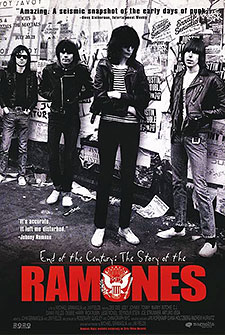
Baseball's Active Leaders, 2023
What Trump Said When About COVID
Recent Reviews
Everything Everywhere All at Once (2022)
Black Panther: Wakanda Forever (2022)
Doctor Strange in the Multiverse of Madness (2022)
Spider-Man: No Way Home (2021)
The Cagneys
A Midsummer Night's Dream (1935)
Something to Sing About (1937)
Angels with Dirty Faces (1938)
A Lion Is In the Streets (1953)
Man of a Thousand Faces (1957)
Never Steal Anything Small (1959)
Shake Hands With the Devil (1959)
End of the Century: The Story of the Ramones (2004)
Halfway through the documentary “End of the Century: The Story of the Ramones,” punk author Legs McNeil asks the question that anyone who tries to reconcile the Ramones’ legend with their music asks: “Those songs are classic American pop. Why weren’t they played on the radio?”
“Century” tries to provide an answer while giving viewers a look at one of the more influential bands of the punk and grunge eras.
The Ramones were geeky kids from Forest Hills, Queens, who listened to the same marginalized music (the Stooges and the New York Dolls) and eventually picked up instruments and began playing. In the early ’70s, because of hard economic times, parts of the lower east side of Manhattan were deserted. The band wound up playing at the punk club CBGB. “There was nowhere else to play,” they recall.
Bands like Television, the Talking Heads and Blondie headlined. Then there were the Ramones, with their scowls, black leather jackets and hair out of some alternative universe where the Herman’s Hermits still ruled. Their music skills were minimal, their songs short, their attitudes bad. People didn’t know whether to laugh or run. “It was like the SS just walked in,” someone recalls.
But many were impressed by their hard-driving rock ’n’ roll. A self-titled record was produced and the band toured England in 1976, where they influenced the Sex Pistols and the Clash. Back in the U.S.? They could barely get gigs in Jersey.
At the time, album rock was geared toward the overindulgence of long guitar solos, while Top 40 radio was dominated by treacly pop (the documentary includes a hilarious K-Tel ad from the period: “22 Explosive Hits!”). When British punk finally broke, the scary Ramones were lumped with the scary Brits. According to the news media—ever fixated on the lurid detail—they vomited on fans. Is this what kept fans away and the Ramones off the radio? Album after album was released—including one produced by Phil Spector—to good notices but lackluster sales.
Meanwhile, discontent was growing within the band. Lead singer Joey Ramone (né Jeffrey Hyman), who had attention deficit disorder, wanted to take the group in new creative directions, while guitarist Johnny Ramone (John Cummings) was an unsmiling disciplinarian who kept the band from altering its sound. He also stole Joey’s girlfriend, which caused an irreparable rift (although the touring continued) and was the cause—it’s speculated in the film—for Joey’s song “The KKK Took My Baby Away.”
“End of the Century” is a satisfying, straightforward documentary with great archive footage and interviews with band members—three of whom are now dead—and those they influenced, including Eddie Vedder, Joe Strummer and Rob Zombie. It may overstate its case, particularly with how much the Ramones influenced the British punk scene, but you can’t argue with the music.
—Origianlly appeared in The Seattle Times on October 29, 2004
© 2004 Erik Lundegaard







